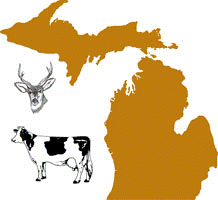Wildlife Disease and Zoonotics
Date of this Version
2008
Abstract
Bovine tuberculosis (TB), first discovered in 2005, has now been found in 12 cattle operations in northwestern Minnesota. To date, all of the infected cattle herds have been depopulated and the Board of Animal Health (BAH) has continued to test cattle herds in the area. The strain has been identified as one that is consistent with Bovine TB found in cattle in the southwestern United States and Mexico. In response to the disease being detected in cattle, the Minnesota Department of Natural Resources (MNDNR) began surveillance efforts in free-ranging white-tailed deer (Odocoileus virginianus) within a 15-mile radius of the infected farms in fall 2005. To date, 25 deer have been found infected with Bovine TB. All infected deer were sampled within a 164mi2 area, called the Bovine TB Core, which is centered in Skime, Minnesota, and encompasses 8 of the previously infected cattle farms. In fall 2008, Minnesota was granted a Split-State Status for Bovine TB by the United States Department of Agriculture (USDA) that resulted in a lessening of testing requirements for cattle in the majority of the state (status level = “Modified Accredited advanced”), with a small area in northwestern Minnesota remaining more restrictive (status level = “Modified Accredited”). Also in 2008, the Minnesota State Legislature passed an initiative that allocated funds to buy-out cattle herds located in the Bovine TB Management Zone, spending $3 million to remove 6,200 cattle from 46 farms by January 2009; resulting in the discovery of the 12th infected cattle herd. The remaining cattle farms in the Bovine TB Management Zone (n = 27) were required to erect deer-exclusion fencing to protect stored forage and winter feeding areas, costing an additional $690,000 in state funds. In November 2008, the MNDNR conducted Bovine TB surveillance of hunter-harvested white-tailed deer within the newly created Modified Accredited Zone, and results indicated that none of the 1,246 deer tested were positive for the disease. This marked the first large scale surveillance effort that failed to detect the disease in hunter-harvested deer since sampling efforts began in 2005. MNDNR also conducted targeted removal operations in the Bovine TB Core Area, using both aerial and ground sharpshooting, during winters 2007, 2008 and 2009. These intensive winter deer removal operations removed a combined total of 2,163 deer and detected 13 (52%) of the TB-positive deer discovered to date. Further, a recreational feeding ban, covering 4,000mi2 in northwestern MN, was instituted in November 2006 to help reduce the risk of deer to deer transmission of the disease and enforcement officers have been working to stop illegal feeding activities. The MNDNR will continue to conduct hunter-harvested surveillance for the next 5 years to monitor infection in the local deer population, and consider the continuation of aggressive management actions (e.g., sharpshooting deer in key locations) to address concerns of deer becoming a potential disease reservoir.


